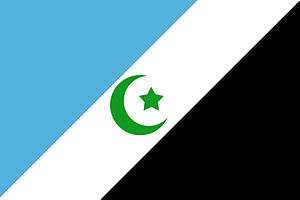Shabak Militia
| Quwwat Sahl Ninawa | |
|---|---|
|
قوات سهل نينوى Participant in Iraqi Civil War (2014-present) | |
 | |
| Groups |
|
| Part of |
|
| Allies | |
| Opponents |
|
| Battles and wars | Iraqi Civil War (2014-present) |
The Shabak Militia is an armed group that formed in 2014, with around 1,500 militiamen, to regain control of the Nineveh region from the Islamic State. Further goals, beyond regaining control of the region, were to protect against and oppose The Islamic State. The Iraq Parliament Representative of the Shabak Community, Salim Juma, obtained a verbal approval to form this militia for the purposes stated.[2] Juma informed news sources of this move in September 2014, the group officially formed as the Quwat Sahl Nīnawā (QSN) on November 23, 2014. Videos later released by the group, however, appear to only show 500 fighters at most, though accurate estimates can not be drawn from said videos. The group is said to be heavily opposed to Kurdish control, but seem to be primarily dedicated to driving The Islamic State out. The group is composed of Shia Muslims from the Nineveh Region.
Name and culture
The name of the group Quwat Sahl Nīnawā, translating to English as Nineveh Plains' Forces, directly refers to the Nineveh region, an area containing one of the largest populations of Shabak people. The Shabak people are an ethno-religious group in Northern Iraq claiming distinct ethnic differences from Kurds and Arabs, while practicing a religion known as Shabakism. However, the militia is pro-Shia, and has anti-Sunni sentiments, which may be due to the strong Shiite influences in their faith.[3]
References
- 1 2 3 http://www.rubincenter.org/2017/10/hashd-brigade-numbers-index/
- ↑ Hussein, Ahmed. "Shabak Community forms military force of 1500 fighters to fight ISIS in Nineveh". Iraqi News. Retrieved 2015-07-10.
- ↑ Zelin, Aaron (2015-01-12). "Hizballah Cavalcade: Quwat Sahl Nīnawā: Iraq's Shia Shabak Get Their Own Militia". Jihadology. Retrieved 2016-09-18.